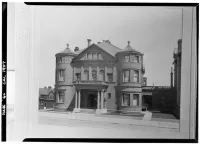Share what you know,
and discover more.
Share what you know,
and discover more.

-

- Marley Zielike
Whittier Mansion, 2090 Jackson St San Francisco, San Francisco County, CA
Built for William Franklin Whittier between 1894 and 1896, this massive Arizona sandstone building has passed through a number of interesting owners. Occupied as a residence until the early 1940s, it was sold to the German Reich in 1941 as a San Francisco consulate. Seized by the Alien Property Custodian (later transferred to the Attorney General of the US) during WWII, it was auctioned in 1950 to Mrs. Echo Leonetti. From her it passed to George and Mary Barton, thence to Robert Wilhelm and Isabell and Paul Dessez, and finally to the California Historical Society in 1956. Mortimer Adler`s Institute of Philosophical Research occupied part of the building from 1952 to 1956. It is one of the few major houses of the later 19th century to survive to the present day, and is an interesting combination of massive Richardsonian Romanesque with Period styling. The architectural details of the interiors are exceptional in material and in preservation; they reflect studious variations of historical sources which marked the end of 19th century American architecture.
Whittier Mansion, 2090 Jackson St San Francisco, San Francisco County, CA
Built for William Franklin Whittier between 1894 and 1896, this massive Arizona sandstone building has passed through a number of interesting owners. Occupied as a residence until the early 1940s, it was sold to the German Reich in 1941 as a San Francisco consulate. Seized by the Alien Property Custodian (later transferred to the Attorney General of the US) during WWII, it was auctioned in 1950 to Mrs. Echo Leonetti. From her it passed to George and Mary Barton, thence to Robert Wilhelm and Isabell and Paul Dessez, and finally to the California Historical Society in 1956. Mortimer Adler`s Institute of Philosophical Research occupied part of the building from 1952 to 1956. It is one of the few major houses of the later 19th century to survive to the present day, and is an interesting combination of massive Richardsonian Romanesque with Period styling. The architectural details of the interiors are exceptional in material and in preservation; they reflect studious variations of historical sources which marked the end of 19th century American architecture.
Whittier Mansion, 2090 Jackson St San Francisco, San Francisco County, CA
Built for William Franklin Whittier between 1894 and 1896, this massive Arizona sandstone building has passed through a number of interesting owners. Occupied as a residence until the early 1940s, it was sold to the German Reich in 1941 as a San Francisco consulate. Seized by the Alien Property Custodian (later transferred to the Attorney General of the US) during WWII, it was auctioned in 1950 to Mrs. Echo Leonetti. From her it passed to George and Mary Barton, thence to Robert Wilhelm and Isabell and Paul Dessez, and finally to the California Historical Society in 1956. Mortimer Adler`s Institute of Philosophical Research occupied part of the building from 1952 to 1956. It is one of the few major houses of the later 19th century to survive to the present day, and is an interesting combination of massive Richardsonian Romanesque with Period styling. The architectural details of the interiors are exceptional in material and in preservation; they reflect studious variations of historical sources which marked the end of 19th century American architecture.Posted Date
Sep 27, 2021
Source Name
Library of Congress
Source Website
Delete Story
Are you sure you want to delete this story?










